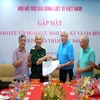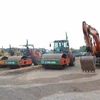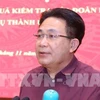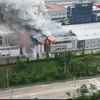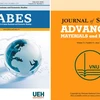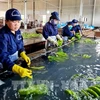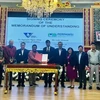Hanoi (VNA) - Affirming the urgency of investing in high-speed North-South railway, however, the options to implementing the project are being scrutinised by ministries, branches, experts and scientists about the feasibility and effectiveness of the project as well as the technological mastery of our country.
At the seminar held on July 19 discussing technology solutions for the North-South high-speed railway project, the representative of the project, TEDI-Tricc-TEDI Shouth presented the report on the pre-feasibility study for the North-South high-speed railway project, including the proposal to build a new railway line of about 1,559km, passing 20 localities, connects Hanoi and Ho Chi Minh City.
Regarding the schedule, the first phase is expected to be implemented during 2020-2032 with the construction of Hanoi-Vinh and Nha Trang-Ho Chi Minh City sections. The second phase is expected from 2032-2050 with Vinh-Nha Trang section, of which the Vinh-Da Nang section will be completed in 2040 and the Danang-Nha Trang section will be completed in 2050.
The estimated designed speed is 350km per hour, operating speed is 320km per hour. Regarding this issue, Deputy Minister of Planning and Investment Vu Dai Thang said that the options need to be clarified to be taken into consideration.
“A lower speed option of about 200 km per hour with the total investment of about 26 billion USD is feasible, suitable with the public debt ceiling, meeting Vietnam's needs, ” Deputy Minister Thang clarified the Ministry of Planning and Investment’s viewpoint.
Economically, according to Deputy Minister Thang, the North-South high-speed railway project accounted for a large proportion of GDP, amounting to 58.7 billion USD, accounting for one fourth of our country's GDP.
On that basis, the Ministry of Planning and Investment proposed the investment plan and the Prime Minister decided to set up the State Council for the Evaluation of North-South high-speed railway project.
The Deputy Minister maintained that the project faces dificulties in terms of technology as in fact, our country is only active in cement, sand, gravel and people, but it fails to make access to locomotives.
In addition, Professor La Ngoc Khue, former Deputy Minister of Transport, said that many countries such as Germany, Sweden, Netherlands, Switzerland, the US, Thailand, Russia only produce 200km per hour trains. Therefore, the project needs to clarify the new plan to take technology solutions into account.
"According to the calculations of the consultant, the investment cost is nearly 60 billion USD. If it is built in 30 years, it spends 2 billion USD annually. Meanwhile, the current central budget for the Transport sector is one billion USD each year. Therefore, it will be a difficult problem, "Mr. Khue warned.
Assuming that the railway should transport both passengers and freight to reduce logistics burdens, Mr. Khue evaluated that recommendations of the Ministry of Planning and Investment are appropriate.
According to Le Bo Linh, former Deputy Chairman of the National Assembly's Committee for Science, Technology and Environment, it is not feasible and effective to transport freight and passengers on the same high-speed railway.
Besides, Mr. Linh said that whatever the plan, the railway industry must master the technology, associated with the development of the industry.
Mr. Phan Pham Ha, General Director of Hanoi Mechanical One Member Company Limited, said that with our country's technology, 50-60% of high-speed railway equipment can be made by now.
However, Mr. Ha also expressed concern about how much money the Government will invest in machinery and technology to master technology./.




